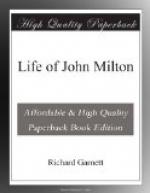One quality of Milton’s pamphlet claims the highest admiration, its audacious courage. On the very eve of the Restoration, and with full though tardy recognition of its probable imminence, he protests as loudly as ever the righteousness of Charles’s execution, and of the perpetual exclusion of his family from the throne. When all was lost, it was no disgrace to quit the field. His pamphlet appeared on March 3, 1660; a second edition, with considerable alterations, was for the time suppressed. On March 28th the publisher was imprisoned for vending treasonable books, among which the pamphlet was no doubt included. Every ensuing day added something to the discomfiture of the Republicans, until on May 1st, “the happiest May-day,” says that ardent Royalist du lendemain, Pepys, “that hath been many a year to England,” Charles II.’s letter was read to a Parliament that none could deny to have been freely chosen, and acclaimed, “without so much as one No.” On May 7th, as is conjectured by the date of an assignment made to Cyriack Skinner as security for a loan, Milton quitted his house, and concealed himself in Bartholomew Close, Smithfield. Charles re-entered his kingdom on May 29th, and the hue and cry after regicides and their abettors began. The King had wisely left the business to Parliament, and, when the circumstances of the times, and the sincere horror in which good men held what they called regicide and sacrilege are duly considered, it must be owned that Parliament acted with humanity and moderation. Still, in the nature of things, proscription on a small scale was inevitable. Besides the regicides proper, twenty persons were to be named for imprisonment and permanent incapacitation for office then, and liable to prosecution and possibly capital punishment hereafter. It seemed almost inevitable that Milton should be included. On June 16th his writings against Charles I. were ordered to be burned by the hangman, which




